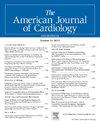Association of Maternal Cardiac Disease and Echocardiographic Parameters With Neonatal Outcomes
IF 2.1
3区 医学
Q2 CARDIAC & CARDIOVASCULAR SYSTEMS
引用次数: 0
Abstract
Women with cardiac disease have worse neonatal outcomes compared to women without cardiac disease; risk factors are not well-defined. We hypothesized that structural heart disease, as assessed by echocardiography, is a noninvasive metric for abnormal hemodynamics and an unfavorable maternal-fetal environment. We assessed the association between echocardiographic markers of structural heart disease in women with cardiac disease and a primary endpoint of adverse neonatal outcomes operationalized as neonates with small-for-gestational-age birth weight, preterm delivery, neonatal intensive care unit/transition care unit admission, or neonatal/fatal demise. Women with cardiac disease who delivered at a tertiary care center between 2014 and 2022 were included. Echocardiographic parameters and neonatal outcomes were collected. A subgroup analysis was performed among women with congenital heart disease (CHD). Among 1,108 women, maternal diagnoses of pulmonary hypertension (OR 5.7, 95% CI 1.8–18.6), hypertensive disease (OR 3.8, 95% CI 2.4–6.2), CHD (OR 2.2, 95% CI 1.3–3.8), and cardiomyopathy (OR 2.0, 95% CI 1.1–3.8) were associated with the primary endpoint. Peak tricuspid regurgitation velocity was associated with the primary endpoint (OR 1.9, 95% CI 1.2–3.1). Biventricular function and severity of valvular disease were not associated with the primary endpoint in the total study population and in the CHD subgroup. In conclusion, maternal cardiac diagnosis is associated with adverse neonatal outcomes. Structural heart disease as assessed by echocardiography was not predictive of adverse neonatal outcomes. Large-scale studies are needed to identify drivers of adverse neonatal outcomes in women with cardiac disease.
母亲心脏病和超声心动图参数与新生儿结局的关系:新生儿结局的回声预测因子。
与没有心脏病的妇女相比,患有心脏病的妇女的新生儿结局更差;风险因素没有明确定义。我们假设,通过超声心动图评估的结构性心脏病是血液动力学异常和不利母胎环境的非侵入性指标。我们评估了心脏病女性结构性心脏病的超声心动图标记物与新生儿不良结局的主要终点之间的关联,这些不良结局包括胎龄小于出生体重的新生儿、早产、新生儿重症监护病房/过渡护理病房入院或新生儿/致命性死亡。2014年至2022年期间在三级保健中心分娩的心脏病妇女被纳入研究范围。收集超声心动图参数和新生儿结局。在患有先天性心脏病(CHD)的女性中进行了亚组分析。在1108名妇女中,母亲诊断的肺动脉高压(OR 5.7, 95% CI 1.8 - 18.6)、高血压疾病(OR 3.8, 95% CI 2.4 - 6.2)、冠心病(OR 2.2, 95% CI 1.3 - 3.8)和心肌病(OR 2.0, 95% CI 1.1 - 3.8)与主要终点相关。峰值三尖瓣反流速度与主要终点相关(OR 1.9, 95% CI 1.2 - 3.1)。在整个研究人群和冠心病亚组中,双心室功能和瓣膜疾病的严重程度与主要终点无关。总之,母亲心脏诊断与不良新生儿结局相关。超声心动图评估的结构性心脏病不能预测新生儿不良结局。需要大规模的研究来确定患有心脏病的妇女不良新生儿结局的驱动因素。
本文章由计算机程序翻译,如有差异,请以英文原文为准。
求助全文
约1分钟内获得全文
求助全文
来源期刊

American Journal of Cardiology
医学-心血管系统
CiteScore
4.00
自引率
3.60%
发文量
698
审稿时长
33 days
期刊介绍:
Published 24 times a year, The American Journal of Cardiology® is an independent journal designed for cardiovascular disease specialists and internists with a subspecialty in cardiology throughout the world. AJC is an independent, scientific, peer-reviewed journal of original articles that focus on the practical, clinical approach to the diagnosis and treatment of cardiovascular disease. AJC has one of the fastest acceptance to publication times in Cardiology. Features report on systemic hypertension, methodology, drugs, pacing, arrhythmia, preventive cardiology, congestive heart failure, valvular heart disease, congenital heart disease, and cardiomyopathy. Also included are editorials, readers'' comments, and symposia.
 求助内容:
求助内容: 应助结果提醒方式:
应助结果提醒方式:


